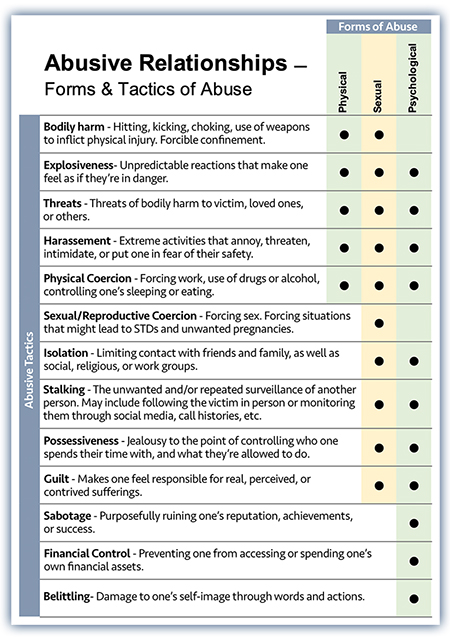All relationships are complex – a melding of unique personality traits that are brought together as a single union. Relationships often develop into some mix between supportive and restrictive, all-consuming and mundane, happy and heartbreaking, loving and hurtful. The worst of these relationships are where personality traits intertwine to form an abusive relationship, resulting in physical, sexual, or psychological harm inflicted by one unto the other. It’s estimated that more than 4.2 million acts of physical assault, rape, and stalking are perpetrated against women annually, and 3.2 million against men within abusive relationships. [1]
 Physical, sexual, and psychological relationship abuse take many forms, as shown in the table at the right. The abuse often occurs as a combination of violent, coercive, controlling, demeaning, and debilitating actions, causing physical, sexual, and/or psychological harm, forced by one onto the other.
Physical, sexual, and psychological relationship abuse take many forms, as shown in the table at the right. The abuse often occurs as a combination of violent, coercive, controlling, demeaning, and debilitating actions, causing physical, sexual, and/or psychological harm, forced by one onto the other.
Early Warning Signs
Relationship abuse begins with what might seem to be minor offenses – actions that could be overlooked, excused, or rationalized as results of quirky humor, too much stress, or too much alcohol. Trouble may begin with only a single aspect of abuse, with new tactics added over time. Warning signs of relationship abuse include:
- A relationship pushed ahead too quickly.
- Bouts of jealousy and possessiveness, and a disrespect for individual’s boundaries.
- Isolation, caused by subtle restrictions of healthy relationships and desired activities
- Surveillance of the victims contacts, activities, calls and texts. The elimination of personal privacy.
- Criticism and blame tactics that are used to cause feelings of inadequacy, unattractiveness, and guilt.
- Control of money and financial assets such as checkbooks, credit cards, and bank accounts.
- Fits of rage. Fear of bodily harm.
Early warning signs should not to be overlooked. They should be documented to validate steps taken for the victim’s protection in the future.
Escaping From Abuse
With relationship abuse, coercion, control, harassment, and isolation develop to the point where significant physical, sexual, and/or psychological harm is being inflicted. It often includes isolation which makes it more difficult for family and friends to provide assistance, and often the victim is emotionally battered by the ongoing belittlement, fear, and coercion. At this point ensuring one’s safety and escaping from the abusive relationship have become monumental tasks. Some considerations for escaping abuse include:
- Untraceable communications – Overcoming an abuser’s surveillance is often a challenge, particularly if they have access to the passwords of electronic devices. A well-hidden prepaid phone (hidden along with a charger and important contact information) provides a means of communication before and after the escape that is more difficult to trace.
- Support network – A network of trusted friends, neighbors and family is critical for ensuring timely help before and after an escape. Trusted neighbors can be asked to call family or law enforcement if they hear any indications of violence. A code word can be established that when used, will warn friends or family when a situation becomes dangerous.
- Escape routes – The safest locations inside the house can be identified (e.g. near an exit, away from weapons), and a clear understanding of multiple escape routes out of the house can be planned.
- Places to go – Determine safest place to go upon escaping, including a backup location. Have necessary keys and contact information readily available.
- An escape kit – well hidden, but available. The kit would include:
- Money (cash, credit cards, checkbook)
- Identification (driver’s license, Social Security card, health plan cards, birth certificates)
- Important papers (Police records, insurance, lease)
- Necessities for you and children (clothes, eye glasses, medications, diapers, formula)
Escaping from an abusive relationship is a monumental task, and is likely the first step in a complicated strategy for ongoing protection and security – where a perpetrator’s continued efforts towards surveillance, control, and coercion must be thwarted.
The Mental Health Aspect of Relationship Abuse
It is often the case that mental health considerations are the last to be addressed or are not addressed at all. More immediate actions such as the escape and safety of the survivor, the care of any physical wounds or lingering health issues (e.g. headaches, insomnia, chronic pain), and the protection against any further abuse take priority. But not to be overlooked are mental health issues, that are experienced by an estimated 20% of survivors after struggling with relationship abuse. Many go on to develop symptoms of major depressive disorder, generalized anxiety disorder, post-traumatic stress disorder, and/or increased substance abuse. Survivors are often reluctant to seek help. Therapy for recovering from the depression, anxiety or PTSD include cognition, motivation and behavior interventions.
- Cognitive behavioral therapy (CBT)
- Trauma‐focused CBT (TF‐CBT)
- Integrative therapies
- Behavior therapies
- Eye Movement Desensitization Reprocessing (EMDR),
- Relaxation techniques
- Support groups
We Can Help
As with other types of depression, anxiety, and PSTD, mental health symptoms from relationship abuse can get worse and lead to further complications if not treated. If you or someone you know are experiencing mental health issues from relationship abuse, consider scheduling a teletherapy appointment to come up with a treatment plan that can help address the issues.
[1] Black MC, Basile KC, Breiding MJ, Smith SG, Walters ML, Merrick MT, Chen J, Stevens MR. National intimate partner and sexual violence survey (NISVS): 2010 summary report. Atlanta, GA: National Center for Injury Prevention and Control, Centers for Disease Control and Prevention; 2011.
How to Start the Healing
Beginning the process is easy. Learn more about our Providers (Click Here).
For Teletherapy details (Click Here) or Teletherapy instructions (Click Here)
Call us at 952-224-8990 to make an appointment.






